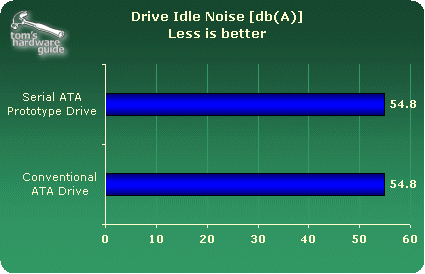Back To The Future: Serial ATA Arrives At Last
Temperature

Drive Idle Noise

The Bottom Line: There's No Rush!
There are two reasons why Serial ATA should easily become established. First, it offers a simpler, more efficient way of handling data than parallel ATA. Second, there is currently no pressure for a faster interface, and serial ATA offers exactly the same speed as UltraATA/133. Moreover, we are hardly likely to witness the arrival of hard disks with transfer rates anywhere near 100 MByte/s in the next few months.
The benefits of the new standard hit home as soon as you take the controller and disk drive out of their packages. The cable is nice and compact, which means the case will be tidier inside, allowing much better air circulation. Even inserting the connectors is foolproof and easy - a little too easy, perhaps, as the connector is apt to dislodge itself at the slightest touch and cause your system to reboot.
The benchmarks do not show the current performance potential of Serial ATA. On the one hand, all available controllers are linked through the PCI bus, which limits the maximum transfer rate to approximately 100 MByte/s - that's as fast as the PCI bus will allow. On the other hand, the performance of the prototype is based solely on the performance on the equivalent conventional ATA drive, which was a limiting factor.
From the performance perspective, there is nothing to be gained from changing over to Serial ATA. The next generation of disk drives from Seagate, Maxtor, and WD and Co. is just around the corner, and it will still be well served by UltraATA/100. Anyone considering Serial ATA is more likely to be swayed by the robustness of its data handling and by the price of Serial ATA drives being pitted against that of conventional ATA disk drives.
Stay on the Cutting Edge
Join the experts who read Tom's Hardware for the inside track on enthusiast PC tech news — and have for over 25 years. We'll send breaking news and in-depth reviews of CPUs, GPUs, AI, maker hardware and more straight to your inbox.
Most Popular

